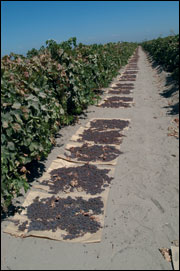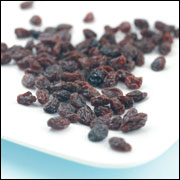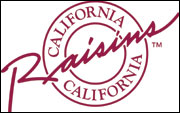 Imports of California raisins into Western Europe for the year ending March 2008 were up 49% on 2007 at 40,121 metric tonnes, fuelled by a combination of the weak US dollar and soaring prices of Turkish raisins following a smaller than expected crop in Turkey last year. It’s great news all round for the major Californian raisin producers represented by the Californian Raisin Marketing Board, and a boost for the Raisin Administrative Committee’s work over the last few years raising awareness and increasing trade and consumer purchases of California Raisins in the UK and Europe. The Grocery Trader spoke to Peter Meadows, UK and Europe Marketing Director for the Raisins Administrative Committee.
Imports of California raisins into Western Europe for the year ending March 2008 were up 49% on 2007 at 40,121 metric tonnes, fuelled by a combination of the weak US dollar and soaring prices of Turkish raisins following a smaller than expected crop in Turkey last year. It’s great news all round for the major Californian raisin producers represented by the Californian Raisin Marketing Board, and a boost for the Raisin Administrative Committee’s work over the last few years raising awareness and increasing trade and consumer purchases of California Raisins in the UK and Europe. The Grocery Trader spoke to Peter Meadows, UK and Europe Marketing Director for the Raisins Administrative Committee.
The Grocery Trader – We last spoke a couple of years ago. What’s been happening for California Raisins since then?
Our main focus has been on marketing California Raisins to the bakery and food manufacturing sectors, which together take 60% of our UK raisin imports. We help them discuss their needs for quality ingredients going forward and work with them to promote their finished products that contain California raisins to the consumers.
GT – How has that been going?
Pretty well, particularly in bakery – bakery usage of California Raisins has increased 22% over 2007, with 23 new mainstream bakery products containing them. In addition California Raisins are now on the sales lists of every major UK bakery ingredients supplier.
GT – What other manufactured products are raisins used in? How are you encouraging the makers of these products to use California raisins?
Raisins are used in dairy, confectionery, snacking, snacking mixes, sauces and condiments – and even beer!
GT – Are you also involved in promoting raisins in snacking?
Yes, we are. Snacking accounts for 30-40% of California Raisins shipped here, and the volume is growing 6% per year. That said, the bulk of UK snacking raisin sales are branded, so we tend to leave consumer communication to the brand owners, apart from some specific generic initiatives.
 GT – As mentioned in the introduction, the biggest California Raisin development in recent months is the surge in imports in the wake of the problems in Turkey. Just how bad was the shortfall in the 2007 Turkish raisin crop?
GT – As mentioned in the introduction, the biggest California Raisin development in recent months is the surge in imports in the wake of the problems in Turkey. Just how bad was the shortfall in the 2007 Turkish raisin crop?
From talking to people in the business, we understand the Turkish export tonnage shortfall was around 25%. This was due to the Mediterranean basin experiencing the hottest summer for 105 years, which affected a lot of dried fruit production and pushed prices to record levels, so buyers sourced raisins elsewhere, notably from California.
GT – What is the situation likely to be this year?
Our sources suggest Turkish raisin prices have firmed for 2008, indicating the likelihood of further strong demand for California raisins.
GT – What effect has the recent weak dollar had on California raisin uptake in the UK and Europe?
A number of factors have helped boost demand for California raisins, including the weaker dollar lowering prices, but the main ones are our guaranteed supply and consistent quality.
GT – What are raisin ‘futures’ looking like for California raisins?
We’re looking at another good crop of around 320,000 tonnes, and continued strong demand. People have been placing orders for double their usual quantity, indicating a superb year ahead. June-October is the buying peak, with a big hiccup around September when the new crop is released.
GT – Given the freak weather events around the world allegedly due to climate change, what is the chance of similar extreme weather in California?
It’s an interesting question! I spent much of February/March looking at long-term weather forecasts for the Mediterranean: some people were saying the recent high temperatures were a pattern, not a freak event.
The Turkish raisin growers are definitely more weather-dependent than the Californians: weather conditions in the San Joaquin Valley are more fixed. It’s also down to smarter water management: in California, irrigation involves dams and controlled supplies, whereas Turkey is more rainfall-dependent.
GT – Where in California do raisins come from?
Raisins are grown in the San Joaquin Valley, within a 50-mile radius of the city of Fresno.
 GT – What kind of grapes are Californian raisins made from? How are raisins produced? What weight of grapes makes a pound of raisins?
GT – What kind of grapes are Californian raisins made from? How are raisins produced? What weight of grapes makes a pound of raisins?
Californian Raisins are made from Thompson seedless white grapes, which are sun dried. 4lbs of grapes make 1lb of raisins.
GT – How do California raisins compare with Turkish raisins in quality?
As major buyers like Tesco and Weetabix will verify, you can recognise California raisins at a glance, whereas Turkish raisins vary widely. All Californian vineyards face East-West, so the grapes are a consistent size, shape and colour. The other factor is the sun drying. Turkey is principally a sultana grower, so the grapes dry in the sun for around a week and are then artificially dried: most growers won’t risk letting the grapes lie on the ground for three weeks, in case it rains and ruins the crop. During the ‘drying’ period in early September, the chance of rain is always minimal in California. The end result is that California raisins are darker, with a more chocolatey flavour: they taste better, and snack better.
GT – How do California raisins compare with raisins from EU countries?
To be blunt, European raisins just don’t match up! To make good quality raisins you need a combination of Thompson seedless grapes, flat, well-drained soil and consistent sun at key times of the year, which is rare in Western or Eastern Europe or elsewhere in the Mediterranean.
GT – What proportion of UK vine fruit imports are raisins?
Out of 113,000 metric tonnes of dried vine fruits imported in 2007, 30-40% was raisins. Sultanas made up 60%.
GT – What proportion of California’s raisin crop is exported to Europe?
About a third of California’s raisin production is exported, or 100,000 tonnes, of which 45,546 is shipped to Northwestern Europe. The UK and Germany together take an 88% share. The UK is traditionally Europe’s biggest importer of dried vine fruit, followed by Germany then Denmark.
GT – What proportion of raisins coming into the UK are Californian?
21 different raisin varieties are imported into the UK from nine countries. Some 50-60% of the total volume of raisins is Californian.
GT – What different forms are California raisins imported to Europe in?
California Raisins are shipped in bulk in their natural form, or as juice concentrate or paste. Each form has its own specific benefits for the end user, such as mould inhibitors or fat replacement. These last two factors are of particular interest to bakery.
GT – Can you explain these terms?
In bakery production, people often add fat to improve the flavour: raisins have a similar effect and are healthier. Raisins also contain a natural phenolic compound, which inhibits mould and extends dough’s shelf life without affecting the colour.
GT – What are the nutrients in raisins?
Raisins are high in anti-oxidants, vitamins A, B2, B6 and C, fibre, iron, calcium, phosphorus, copper, potassium and boron.
GT – What weight of raisins does a child need for 1 of their ‘5 a day’ portions of fruit and veg?
The recommendation is 14g for a small child and 28-30g for an adult. The Raisin Administrative Committee has a licence to promote raisins as having the ‘5 A Day’ accreditation, but individual brands have to apply for it directly.
GT – How long does it take from planting the vine to harvesting the raisins? How environmentally friendly is raisin production?
It takes three years from planting to first harvest. Nut growing uses three times as much water as raisins, so by that yardstick raisins are much more eco-friendly. The economies of scale mean California Raisins are ‘greener’ and cheaper, pro rata, to bring to the UK by ship than Mediterranean raisins, which cross Europe by road.
GT – How does the Raisins Administrative Committee (RAC) work?
The RAC is partly funded by the major Californian raisin packers and partly by the US taxpayer, via the Market Access Program funded from Washington. The UK is the HQ for our activity: we also run our marketing in Germany and Scandinavia from here.
GT – The Garden handles the RAC’s marketing. How does it work?
We act as a marketing agency, handling the representation for the UK and Europe, including creative work, advertising, trade and consumer PR and marketing planning and budgeting.
GT – It’s been five years since you were appointed. How do you think you’ve done?
We’re very much on course: pricing is still a major issue, but unprompted awareness of California raisins’ advantages is running at 45% in retail, and 80% in bakery, versus nothing five years ago. We’ve worked very hard to establish mutually beneficial links with the trade and ‘own’ the raisin category.
GT – What increases in tonnage of raisin imports have you seen since The Garden got involved?
The annual tonnage of California raisins imports to Northwest Europe has risen by an annual average 5% since we started. The UK is still Europe’s biggest importer and has the highest annual per capita consumption, around 4.5kg per person.
GT – What is your (Peter) personal brief as Marketing Director of the CRAC these days? How is it different to before?
My brief is to grow awareness of California Raisins and in so doing increase the annual tonnage of imports, and return value to the growers and packers. Following a regime change at California Raisins in Fresno we’re now more focused on bakery, less on retail, and an increasing part of our remit is rewarding loyalty.
GT – Who are your senior UK marketing colleagues?
I’m helped by Dee Cassey, one of our Marketing Managers, on implementation, and Iain Forbes, another Marketing Manager, on strategy, together with Tim Bates.
GT – Which UK retail outlets are products containing California Raisin stocked in?
We’re in all major multiples and many independent grocers, and also Holland & Barrett and Julian Graves. The health food market is growing in importance, and represents 15-20% of UK retail sales.
GT – What marketing activity do you carry out?
We carry out a mix of communication, including PR, advertising, seminars exhibitions and literature, with our publication Raisin Views, a UK industry update. We also run activity programmes aimed at schools and foodservice.
GT – Who are your target consumers? How has your advertising strategy changed over the last few years?
Our core audience is kids and mums. The fundamental thrust has remained much the same, but with the increasing focus on healthy eating we’re bringing in new initiatives such as supporting GPs and placing promotional material and posters in surgeries. We’ve also been running the California Raisins Innovation awards for the last five years, with the entries increasing each time, which is good for the consumers and for us.
GT – How big a part of your UK market is the ‘lunchbox’ opportunity?
It’s sizeable and growing, with more mums coming in with varying knowledge about raisins’ nutritional aspects.
GT – What impact on children’s raisin consumption have you seen from the ‘Jamie Oliver effect’?
In the past we’ve tended to lose kids after primary school age, because raisins were seen as strictly for children, but the current generation of school kids are increasingly waking up to raisins’ health benefits. The switch from sweets in vending machines has also had a major effect: raisins are now widely used in school canteens, with the cooks becoming more adventurous.
GT – Are you encouraging schools to use raisins in cookery classes?
We recently got involved in a project offering cookery seminars in schools, an area we’ll be developing further.
GT – Do you work with food writers and celebrity chefs to promote use of California raisins in cookery?
We’ve worked over the years with Brian Turner and with Delia and Jamie, and there’s every chance we’ll do so again in the future.
GT – Are California Raisins involved with sponsorship of any sports in the UK?
We’re involved with the English Schools Football Association and are partners in the charity Tennis For Free, which we partly fund. Tennis For Free uses council tennis courts to coach kids, and is endorsed by Dunlop, Slazenger, the LTA, Pat Cash and Bjorn Borg. 100,000 kids have been involved so far. We also run California raisin samplings alongside the coaching sessions.
GT – What external factors do you see affecting UK demand for California raisins, going forward?
The ongoing drivers as we’ve mentioned are the relatively high price of Turkish raisins for their quality and food prices generally. Demand for dried vine fruit overall has been steadily increasing by an average 4% annually and shows no sign of abating, fuelled by concerns about obesity, staying healthy and boosting the immune system.
 GT – Finally, where do you see California Raisins’ imports to Europe and your activities going from here?
GT – Finally, where do you see California Raisins’ imports to Europe and your activities going from here?
I see our imports continuing to rise, along with our marketing activity. There’s considerable evidence that our work is effective, particularly the growth in bakery products containing California raisins. We’re increasingly running more development-oriented activities including co-developing products with companies, and making sure these manufacturers are fully aware of the benefits of raisins as ingredients, such as naturally enhanced shelf life.
This is a good time to be involved in the market: we’re expecting steady growth for the next few years. As and when more countries of origin come in with an acceptable quality product at an acceptable price, California Raisins will continue to lead on all counts.
California Raisins Administrative Committee
Tel: 020 8741 8513
www.raisins.org




Comments are closed.